Find more information in the General Comments section of the assessment
Find more information in the Rating Validity tab of the assessment
- See More
- See More
- See More
- See More
- Good
- Adequate
- Marginal
- Weak
- Poor
 Passenger
Passenger
 Driver
Driver
 Rear Passenger
Rear Passenger
 Driver
Driver
 Car
Car
 Pole
Pole
 Rear Seat
Rear Seat
 Front Seat
Front Seat
- Good
- Adequate
- Marginal
- Weak
- Poor


Passenger
outboard
center
outboard
Fitted to the vehicle as standard
Not fitted to the test vehicle but available as option
Not Available
-
Infants up to 13 kg
-
Infants and toddlers up to 18 kg
-
Toddlers from 9 to 18 kg
-
Toddlers over 18 kg
Easy
Difficult
Safety critical
Not allowed
| Seat Position | ||||||
|---|---|---|---|---|---|---|
| Front | 2nd row | 3rd row | ||||
| Passenger | Left | center | Right | Left | Right | |
| Maxi Cosi Cabriofix (Belt) | ||||||
| Britax Römer King Plus (Belt) | ||||||
| Britax Römer Duo Plus (ISOFIX) | ||||||
| Britax Römer KidFix (Belt) | ||||||
| Maxi Cosi Cabriofix & EasyFix (Belt) | ||||||
| Maxi Cosi Cabriofix & EasyFix (ISOFIX) | ||||||
| BeSafe iZi Kid X3 ISOfix (ISOFIX) | ||||||
| Maxi Cosi Pearl & Familyfix (ISOFIX) | ||||||
| Britax Römer KidFix (ISOFIX) | ||||||
Easy
Difficult
Safety critical
Not allowed
In the full scale impact tests, both the 1½ year dummy and the 3 year dummy were sat in rearward-facing restraints. The Q7 scored maximum points for its protection of the 3 year dummy in the tests. Protection of the 1½ year dummy was good except for the chest, which experienced marginally elevated decelerations. The front passenger airbag can be disabled to allow a rearward-facing child restraint to be used in that seating position. Clear information is provided to the driver and the system was rewarded. All of the restraints for which the Q7 is designed could be properly installed and accommodated in the vehicle. The Q7 can be bought as a seven seater or a five seater. The optional third row seats have, as standard, integrated child restraints with ISOFIX anchorages. The seven seat vehicle would have scored additional points for child occupant protection and the five star overall rating applies also to that version.
- Good
- Adequate
- Marginal
- Weak
- Poor

Head Impact 18.8 Pts
Pelvis Impact 1.4 Pts
Leg Impact 5.2 Pts
The Q7 has an 'active' bonnet. Sensors in the bumper detect when a pedestrian has been struck and actuators lift the bonnet, providing greater clearance between the surface and the hard structures in the engine bay. Audi showed that the system triggered robustly over a range of speeds and for different pedestrian statures, so the car was tested with the bonnet in the raised position. Good results were recorded in almost all areas tested. The bumper had some areas offering good protection to pedestrians' legs but also some adequate and marginal results were recorded. Protection of the pelvic region of a struck pedestrian was predominantly poor.
- Good
- Adequate
- Marginal
- Weak
- Poor
| Speed Limit Information Function | N/A |
| Warning Function | Manually set |
| Speed Limitation Function | Manually set |
| Applies To | All seats | ||
| Warning | Driver Seat | Front Passenger(s) | Rear Passenger(s) |
| Visual | |||
| Audible | |||
|
|||
| System Name | Audi Pre Sense City | |||
| Type | Forward Collision Warning with Auto-Brake | |||
| Operational From | 10 km/h | |||
| Additional Information | Default On; Supplementary Warning; Seatbelt Activation | |||
| Performance | | ||||
| Autobrake Function Only | Driver reacts to warning | |||
| Operational Speed | 10-85 km/h | 30-250 km/h | ||
| Approaching a stationary car | See AEB City | Crash avoided up to 45km/h.Crash speed reduced up to 80km/h. | ||
| Approaching a slower moving car | Crash avoided up to 65km/h.Crash speed reduced up to 70km/h. | Crash avoided up to 70km/h.Crash speed reduced up to 80km/h. | ||
| Following a car at short distance | ||||
| Car in front brakes gently | Avoidance | Avoidance | ||
| Car in front brakes harshly | Mitigation | Mitigation | ||
| Following a car at long distance | ||||
| Car in front brakes gently | Mitigation | Mitigation | ||
| Car in front brakes harshly | Mitigation | Avoidance | ||
The Q7 is equipped, as standard, with electronic stability control, a seatbelt reminder system for the front and rear seats, autonomous emergency braking and a speed assistance system. As well as operating at low, city speeds, the autonomous braking system also works at higher speeds and performed well in Euro NCAP's tests. The standard speed assistance system is a driver-set speed limiter, and this is the system assessed here. An optional system is available which also uses a camera and digital mapping to inform the driver of local speed limits. A lane departure warning system is available as an option but was not expected to meet the fitment requirements for inclusion in the assessment.
- Specifications
- Safety Equipment
- Videos
- Rating Validity
Specifications
Tested Model Audi Q7 3.0 TDI quattro, LHD
Body Type - 5 door SUV
Year Of Publication 2015
Kerb Weight 1995kg
VIN From Which Rating Applies - applies to all 5 and 7 seat Q7's of the specification tested
Class Large SUV
Safety Equipment
Note: Other equipment may be available on the vehicle but was not considered in the test year.
Fitted to the vehicle as standard
Fitted to the vehicle as option
Not fitted to the test vehicle but available as option
Not Available
Not Applicable
Videos
Rating Validity



Find more information in the General Comments section of the assessment
 Share
Share
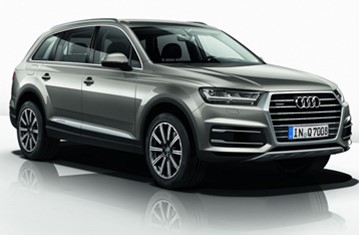
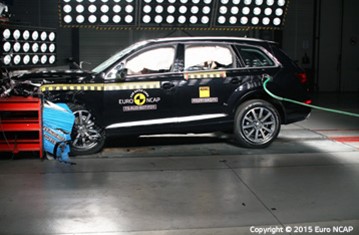
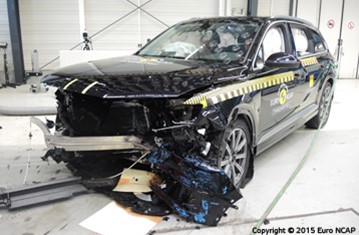
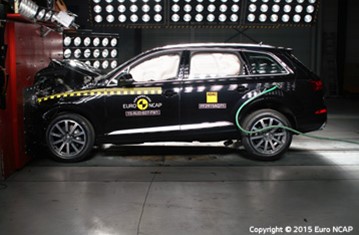
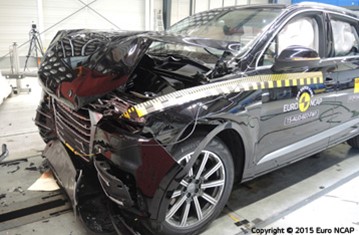
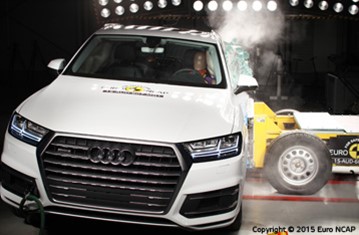
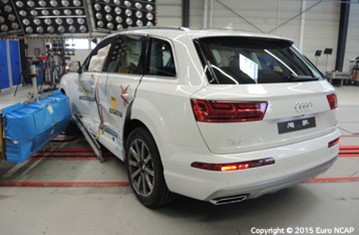
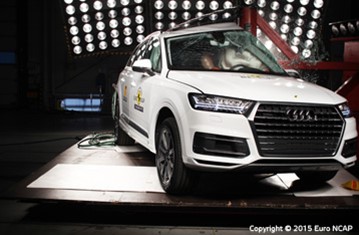
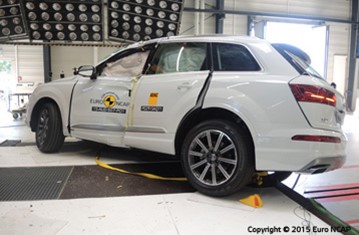



The passenger compartment of the Q7 remained stable in the frontal impact. Dummy readings showed good protection of the knees and femurs of the driver and passenger. Audi demonstrated that a similar level of protection would be provided to occupants of different sizes and to those sat in different positions. Measurements of chest compression in the driver dummy indicated a marginal level of protection for this part of the body. In the full width rigid barrier test, all critical body areas except the chest were well protected. Chest protection for the rear passenger dummy was adequate and that of the driver dummy was again marginal. In both the side barrier impact and the more severe side pole test, protection of all critical body regions was good and maximum points were scored. The front seats and head restraints provided good protection against whiplash injuries in the event of a rear-end collision, and a geometric assessment of the rear seats indicated good whiplash protection here too. An autonomous emergency braking system is fitted as standard on the Q7 and operates from the low speeds, typical of city driving, at which many whiplash injuries are caused. Its performance in Euro NCAP's tests was good.